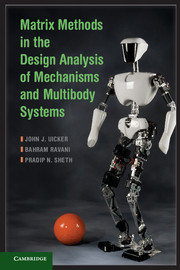Book contents
- Frontmatter
- Contents
- Preface
- About the Authors
- 1 Concepts and Definitions
- 2 Topology and Kinematic Architecture
- 3 Transformation Matrices in Kinematics
- 4 Modeling Mechanisms and Multibody Systems with Transformation Matrices
- 5 Posture Analysis by Kinematic Equations
- 6 Differential Kinematics and Numeric Solution of Posture Equations
- 7 Velocity Analysis
- 8 Acceleration Analysis
- 9 Modeling Dynamic Aspects of Mechanisms and Multibody Systems
- 10 Dynamic Equations of Motion
- 11 Linearized Equations of Motion
- 12 Equilibrium Posture Analysis
- 13 Frequency Response of Mechanisms and Multibody Systems
- 14 Time Response of Mechanisms and Multibody Systems
- 15 Collision Detection
- 16 Impact Analysis
- 17 Constraint Force Analysis
- Index
- References
9 - Modeling Dynamic Aspects of Mechanisms and Multibody Systems
Published online by Cambridge University Press: 05 April 2013
- Frontmatter
- Contents
- Preface
- About the Authors
- 1 Concepts and Definitions
- 2 Topology and Kinematic Architecture
- 3 Transformation Matrices in Kinematics
- 4 Modeling Mechanisms and Multibody Systems with Transformation Matrices
- 5 Posture Analysis by Kinematic Equations
- 6 Differential Kinematics and Numeric Solution of Posture Equations
- 7 Velocity Analysis
- 8 Acceleration Analysis
- 9 Modeling Dynamic Aspects of Mechanisms and Multibody Systems
- 10 Dynamic Equations of Motion
- 11 Linearized Equations of Motion
- 12 Equilibrium Posture Analysis
- 13 Frequency Response of Mechanisms and Multibody Systems
- 14 Time Response of Mechanisms and Multibody Systems
- 15 Collision Detection
- 16 Impact Analysis
- 17 Constraint Force Analysis
- Index
- References
Summary
Introduction
In the very beginning of this text, section 1.1, we observed that the science of mechanics is composed of two parts called statics and dynamics, first distinguished by Euler in 1765. His advice is, perhaps, worth repeating here [1]:
The investigation of the motion of a rigid body may be conveniently separated into two parts, the one geometrical, the other mechanical. In the first part, the transference of the body from a given position to any other position must be investigated without respect to the causes of the motion, and must be represented by analytical formulae which will define the position of each point of the body after the transference with respect to its initial placement. This investigation will therefore be referable solely to geometry, or rather to stereomety [the art of stone-cutting].
It is clear that by the separation of this part of the question from the other, which belongs properly to Mechanics, the determination of the motion from dynamic principles will be made much easier than if the two parts were undertaken conjointly.
We also noted that dynamics is made up of two major disciplines, later recognized as the distinct sciences of kinematics and kinetics, which treat the motion and the forces producing it, respectively.
- Type
- Chapter
- Information
- Publisher: Cambridge University PressPrint publication year: 2013



